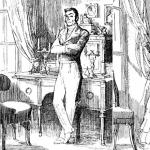Oil paintings. Oil paintings for beginners step by step. Simple oil paintings for beginners. How to paint with acrylic and oil paints at the same time
Have you ever dreamed of painting a beautiful, expressive oil painting? In this article, you will find some tips to help you dive into the wonderful world of oil paints. Once you master the basics of working with oil paints, the canvas will become your fantasy world!
Method 1 of 5: Preparing the Creative Space
Method 2 of 5: Preparing Oil Paints
Method 3 of 5: Getting Started with Writing
The brush should be held by the handle or its protruding part, but up to the metal frame. This will allow you to hold the brush correctly while brushing without squeezing too hard.- First, sketch your future painting with a pencil on canvas. This will help to build a composition, small details, even lines, etc. before starting work with paints. having made a sketch, you can easily make changes to it. First - a sketch with a pencil, and then - painting with paints (of course, if you do not plan to draw something abstractly random).
- As an exercise, practice with black and white colors to paint a palette of all shades of gray from white to black. This will give you a feel for the saturation and contrast.
- Do not be lazy and watch a large number of training videos and painting sites on the Internet. Many generous artists have left a lot of information online for you to use. Search for words such as "painting lessons" or "painting training" and see what the search engine will give you.
- Feel free to ask a more experienced artist for help. He can watch the lice work and give constructive advice on how to improve your technique.
- In the process of creating your painting, it is important to understand what stage you are in. One of the rules: draw from thin to thick. This means it is best to apply a light coat of paint with less oil to the canvas first. This will create a loose paint with one part paint and two parts thinner. As you progress through the stages of your work, each layer will contain more oil and less thinner. Excessive oil can cause the layer to wrinkle when dry.
- When applying colors, make them brighter than in real life. Then the picture will not seem dull and tired.
- Try to place the same color in the same place on the palette - so instinctively you will reach for the right color, so that your sense of color and shade will develop as you work.
- On canvas, don't get carried away with mixing colors. It is very easy to turn an area of a painting into a dirty brown spot when you frequently try to touch up something on several layers of different colors. If you are trying to fix something and you did not succeed on the first try, then it is better to erase the entire area with a rag - the paints will easily come off the canvas.
- Oil paints take a long time to dry, so you have plenty of time to wipe off the paints within 24 hours of application. As with other paints, if the layer is too dense, it will not dry completely over time.
- If you are painting outside, then stand so that the sun does not fall on the canvas or on the palette. Both the canvas and the palette should be in the shade, in excessive sunlight, you will mix colors incorrectly and, when you come home, you will find that the picture turned out to be dirty and dark.
- When working outdoors, you should limit yourself to fewer colors. You can prepare the necessary colors at home and then you will not have to take all the paints on the "battlefield".
- The work should dry in a cool, dry place where it will not be smeared, scratched, touched, etc. Do not leave the painting to dry in the dark, this can lead to yellowing of the paints, as the work will be covered with a light film.
- Don't leave the painting to dry in a place full of insects - they leave horrible stains on fresh paints when they stick to them.
Oil painting seems complicated at first glance. In fact, you can master this art on your own. It is very pleasant to work with soft thick paints. Pure colors are pleasing to the eye, awakening the imagination. The main thing is to prepare everything you need and master the first artistic skills.
How to paint with oil on canvas?
The secret to the charm of oil paintings lies in the texture of the paints. Composed of colored pigments and linseed oil, they perfectly reflect light, blend easily to create new shades. A novice artist should learn the technique of painting and create conditions for a comfortable work.
Here's what needs to be done.
- Set up a studio. You need to work in a bright, well-ventilated area. A veranda, an attic will do, in the summer - a gazebo in the garden.
- Buy tools and materials. At first, it will be enough to use 5 colors - red, blue, yellow, white, black. You will need 3 brushes of different thicknesses, made of synthetics or pork bristles, as well as a palette knife - a small artistic spatula.
- Prepare a plane for drawing. So that the strokes lie flat, the surface is primed. This is not necessary - many great artists have worked without primer. But it's better for a beginner to stick to tradition.
- Mix materials. Writing using pure tube dye is difficult. Most painters prepare a mixture of paints, turpentine and linseed oil. The proportions are selected individually - the more thinner, the thinner the paint and the softer the smear.
- Practice mixing paints. By combining different color combinations with a brush, interesting shades are obtained.
After taking the preparatory steps, you can start creating the picture.
How to paint with oil on canvas
Professional painters work on linen, wood panels, and even heavy paper. For beginners, a primed canvas is recommended. You can buy it from an art store or craft it yourself. To do this, the fabric is covered with a mixture of PVA glue and white water-based paint in a ratio of 1 to 10. Apply three layers, letting each dry properly. The further procedure is as follows.
- Sketch on the ground with a pencil or charcoal.
- Apply underpainting - the basis of the composition. It is painted with a thin layer of paint diluted with turpentine. Wait for the paint to dry.
- Write the main layer of the picture. Here, linseed oil is used as a diluent. The strokes are made smaller and thinner.
- Correct shortcomings. The surface will be wet for 3-4 days. During this time, you can scrape off the paint in individual places and rewrite them.
- Cover the image with varnish. The varnishing is done on a completely dry surface.
The artist always tries to show his connoisseur what his soul feels, strives to convey how he sees the world around him. This feature lies not only in what the artist depicts, but also in what technique he works. The material used by the master is also important. Oil paints, unlike acrylic, gouache and watercolors, have a long drying property, since the layer of oil paints can remain wet for a long time. When drying, if any detail in the future picture did not suit the artist and there was a need to fix something, the thick oil layer can be removed using a special knife - a palette knife.
Then a new layer of paint can be easily applied to the canvas! In addition, the oil has another specific feature: thanks to its slow drying, the artist can mix colors, turning them into an incredible palette of color variety and smooth color transitions.
How to paint First of all, you need to choose the paint itself. In this matter, the main criterion in the selection of material is its quality. Oil paints of class "AA" are quite resistant compared to paints of class "C", since the latter quickly fade and lose their saturation. Oil painting for beginners should start with an introductory theory, because first of all you need to know the material you are working with and be able to choose and apply it correctly. This situation occurs when, when applying a second coat of oil to the canvas (without first drying the first coat), the color of the image changes. In this regard, it is necessary to familiarize yourself in detail with the peculiarities of the composition of paints and the nuances of their use.

How to paint with oil paints and how to mix them? Presenting the artist's image, on a subconscious level, a picture of a man with a scarf in a "French" beret appears, holding a large palette with brushes in his hands. It is the palette that is the main element of the artist's image. Mostly, palettes are made of wood and have a shape that is comfortable to hold in your left hand along with brushes. These have a hole for the thumb. It should be noted that a good wood palette is processed and soaked in oil and then dried. This procedure is necessary so that the oil present in the palette is not absorbed, since otherwise, the paints are subject to rapid drying.
How to paint with oil paints and which brushes are best to use? Oil painting requires a separate approach to the selection of materials. flat bristle should be chosen with oil. An important point is that you cannot write with one brush. In the process of creativity, the brush is not washed (only at the end of the work), so using the same brush for light and dark colors can lead to incorrect mixing and "contamination" of the base color.

How to paint with oil paints on canvas? The canvas is the basis for the future painting. In order for the picture to turn out realistic and rich, it is necessary to choose the right material from which the canvas is made. For oil painting, hemp or linen is suitable. The fabric of your canvas should be knot-free, even and dense. An important point: be sure to prime the canvas! In specialized art stores, you can purchase either a ready-made primed canvas or perform this procedure yourself.
Someone who does not know how to do this? Painting a person with oil is a complex multi-stage process that requires certain knowledge and skills. In addition to the fact that you need to perfectly know the proportions of the human body and be able to correctly and correctly compare them, writing such a portrait in oil requires additional knowledge of the preparatory stages of working with materials, the stages of applying and mixing paints. Therefore, a young, novice artist should initially accustom himself to thoughtful, systematic, serious work and the correct attitude towards the material with which he works.
Greetings, dear readers!
In this article, we will talk about the basics of working with oil paints. Of course it is the most popular technique in the world. The greatest masters of painting have studied, improved and created with oil paints over the centuries.
By the way, do you know when the first oil-based paints appeared? Most likely you thought about the 14-15th century and ... you were wrong. Many people think so. But just recently, scientists have done ... Open this news too!
Detailing the picture with a thin liner
It is quite logical if and you want to start your creativity with oil paints. And if you have never done this before, but really want to start, you should first find out what a novice artist should have at hand and how to start painting with oil paints.
How to create your own artist set?
- We buy the necessary paints
My top tip for aspiring artists: buy quality paints right away, do not try to save money! The benefits of cheap paints are not great, but there will be a lot of headaches. When you practice constantly, you will be able to assess the quality of your work, which will directly depend on the quality of the paints.
Absolutely it is not necessary to buy a large set, as there are always colors that are never used. To start writing with oil paints, it is enough to limit yourself to a few separate tubes. To develop a skill, a novice artist is recommended to have the following palette:

In general, the palette of paints consists of 3 basic (primary), from which all other colors are obtained by mixing (secondary and tertiary) And when you learn how to mix them, you will understand how and from what it is obtained. Everything around us consists only of red, blue and yellow ... It's amazing, isn't it?
- Choosing brushes
Second important tip for newbie artists: be careful when buying brushes! Inspect them so that the connection (clamp) between the pile and the handle is as tight as possible. Believe me, there is little pleasant in the fact when the pile comes out from the brush and you have to remove it from the wet canvas all the time!
From experience I will say that good brushes will last you more than one year if they are of high quality and you handled them correctly.
For beginners to paint with oil paints, I recommend starting with flat and semi-circular flat brushes. It is enough to purchase 4-6 different sizes. You also need round brushes to detail objects in the picture.

Quality brushes are often a favorite
Over time, you can add retouching brushes, fan brushes and liners to your collection. In another tip article, you can learn more about which brushes are in size, shape and
- We select thinners and solvents
To dilute (liquefy) oil paint to the desired consistency, you need special liquid substances: mostly turpentine or refined linseed oil. Also, many artists use "Doubles" and « Tees "- auxiliary means for paint dilution. On the market of foreign manufacturers there are various mediums, which I also use. In principle, these are the same tees in our understanding.

Important things for every artist
Not recommended for thinning use solvents in their pure form (white spirit, turpentine), because they break the structure of oil paint and "steal" its shine. But you will still need a thinner to clean brushes and other tools, as well as stained hands from paint.
- We buy a palette
It is impossible to imagine a working artist on a painting without a palette in hand! This useful thing performs several functions: paints are placed on it, paints are mixed on it, oil cans (special containers) with thinners of oil paints are attached to it.
Therefore, in order to paint correctly with oil paints and create many shades, I recommend acquiring a suitable palette. Wooden or plastic, large or small, square or round ... The choice is yours.
- Preparing the canvas
Canvas is most often used as a basis for oil painting.Fortunately, a modern artist can buy a ready-made primed canvas on a stretcher.
Almost every art store on sale has canvases of different sizes and from different materials: natural (linen, cotton) and synthetics. I advise natural materials, they are denser and do not sag much over time.
If you have a desire to prepare the canvas yourself, then for this you need to prepare a stretcher and pull the fabric over it very tightly. Then you need to prime the fabric to get a canvas. Sagging of the canvas is common, therefore after priming, you need to drag the canvas a little tighter. More about how to make a canvas with your own hands

We prepare the canvas ourselves
Note: Linen is the best canvas base. It can be fine-grained, medium-grained and coarse-grained. The grain of the canvas determines the smear on the surface. About choosing a canvas
- Acquiring an easel
Of course, you can learn to paint with oil paints without an easel by attaching a canvas to any surface. But still, with an easel it is much more convenient: it is installed at the desired angle at eye level and gives a better view of the picture.
With an easel, it is convenient not only to write, but also to find flaws in the work, and correct them immediately. An easel is a reliable support for your future painting! They come in different heights and comfort, as well as tabletop mini-easels for small canvas sizes.
- Stocking up auxiliary accessories
Have you already thought where your brushes will be? Where will you wash them? How will you scrub the paint off your hands and other utensils? Be sure to stock up on jars to wash your brushes in, paper towels, old newspapers, and a few cotton rags.
These important little things should always be at your fingertips, so that you can work calmly and focus your attention on the painting and not on the materials. All this will be indispensable for you in your work to clean a brush or palette knife, or, for example, remove excess paint from the canvas and wipe your dirty hands.
- Other important materials and accessories
An indispensable tool for working with oil - palette knife! With its help, it is convenient to remove excess paint from the canvas and transfer it to the palette. It also leaves amazingly voluminous strokes! In principle, one palette knife is enough.
But if you decide to learn how to paint well with oil paints and devote a lot of time to this activity, it is better to purchase several such tools of different shapes and sizes.
Sketchbook - a special box for transporting paints and painting accessories. You will really need it if you decide to go out to paint in oil on nature or open air, as it is also called (from French Plain air - outdoors, in the fresh air)
Oiler- small containers with a clip, with which they are attached to the palette. There are two types: simple and double. 
Another important element is protective varnish. The finished painting is usually varnished 6-8 months after the completion of the work. The varnish protects the painting from ultraviolet radiation, moisture and darkening…. Well, and a number of other reasons why varnish the picture. In addition, varnish makes the colors richer and brighter, giving intensity to the paint layer. How to varnish a painting
Howto start painting correctly with oil paints when the artist's kit is assembled?
So, you have collected everything you need, the primed canvas is fixed. What to do next? Start writing!
I know that many aspiring artists have a fear of white canvas that something can go wrong and everything will be ruined. Do not be afraid, because the main thing is to just start! But how to stop being afraid and start painting,.
You can start with an uncomplicated plot that comes to mind ... For example, a mosaic drawing with selected bright colors, which consists of different shapes, forms and symbols. Well, like the ancient Egyptian, remember? Or you can take the finished image and try to copy it onto the canvas ...

Start painting - feel the power of color!
Exists . The most common of them are - and . Most of the most famous canvases are written in them, although there are many other techniques.
For those who are just starting the path of an artist, now the main thing is to start in order to just feel the structure of oil paint, how it lays down on the canvas, how the paint layer is obtained.
By the way, did you know that creative people possess?
Here are some more tips:
- Set up a drawing corner in your apartment. There should be enough light to work during the day without additional lighting. It is in the place of the best natural light that we put the easel. If there is not enough natural light, use additional lighting so that the light falls well on the easel.
- Try to apply oil paints evenly, achieve uniformity on the canvas. If you really want to apply a second layer, take your time; sometimes you need to give time for the first layer to dry out.
- Mix colors! Experiment with shades. Remember that whites make any color lighter and blacks darker, making it easy to achieve the desired shade of shadows and highlights. But do not get too carried away with black and white, since titanium white, for example, makes some colors cloudy, and black is rarely used in classical painting at all. Although on sale from each manufacturer there are several black shades. An alternative to black can be dark indigo ... it is softer and softer in appearance.
"Painting is the most accessible and convenient of the arts" - Johann Goethe, German poet, philosopher and thinker
These little tricks are enough to get you started with oil painting. If you like the Art process and want to delve into it deeper, at a more modern level, I will gladly share my experience with you.Additional Video Tips:
Friends to articledid not get lost among many other articles on the web of the internet,save it to bookmarks.This way you can return to reading at any time.
Ask your questions below in the comments, usually, I answer all questions quickly






